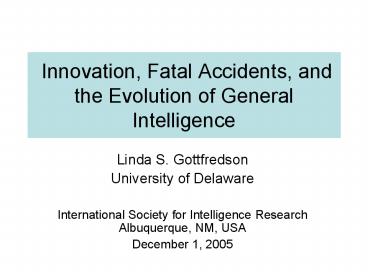Innovation, Fatal Accidents, and the Evolution of General Intelligence - PowerPoint PPT Presentation
Title:
Innovation, Fatal Accidents, and the Evolution of General Intelligence
Description:
International Society for Intelligence ... ritual club fights. non-sanctioned murder. 3. 3. 4. 1. 3. 23. 19. 2. 1. 1. 6. 4. 1. 1. Accident. jaguar/snake ... – PowerPoint PPT presentation
Number of Views:69
Avg rating:3.0/5.0
Title: Innovation, Fatal Accidents, and the Evolution of General Intelligence
1
Innovation, Fatal Accidents, and the Evolution
of General Intelligence
- Linda S. Gottfredson
- University of Delaware
- International Society for Intelligence Research
Albuquerque, NM, USA - December 1, 2005
2
Humans Remarkable Intellect
Encephalization quotient (EQ) brain-to-body
size compared to the average mammal
Homo sap. sap.
Homo sapiens
Homo erectus
Homo habilis
FIRE
Australopithecines
Chimp
3
The Explanadum
- Human Intelligence
- Psychometric viewg
- General ability to learn reason
- General (cross-domain) utility
- Instrumental (not socioemotional)
- Evo Psych viewsvaried, but mostly not g
- Modular Narrow, domain-specific, automated
- (many fast and frugal heuristics)
- Social intelligence (not ecological
competence)
E.g., Fitness signaling survival theories
consistent with g
So, most Evo Psych theories leave g unexplained.
4
What Must an Explanation of g Specify?
- Cross-domain value (common cognitive demands
across different task domains in Homo ecology) - Differential impact on survival (g-related
differences in task performance must create
g-related differences in survival/reproduction) - Ecological demands that are unique to genus Homo
- Conditions that accelerated selection for g in
Homo sapiens
Need to lay out a nitty-gritty selection walk
5
Natural Selection, or Sexual Selection?
- My focus here on natural selection
- I.e., external, physical environment matters
- Sexual selection for g may also operate, but is
not plausibly the whole answer - Why would it select so strongly for g only among
humans? - What would trigger runaway selection for g?
- What about all those individuals who die before
reproductive age?
6
1. Ecological DemandsHow General?
- Clues from analyzing modern jobs
- Cognitive complexity is major distinction
- Example Judgment Reasoning Factor
- Deal with unexpected situations
- Learn recall job-related information
- Reason make judgments
- Identify problem situations quickly
- React swiftly when unexpected problems occur
- Apply common sense to solve problems
None of these is domain-specific.
7
But wasnt life simpler in the early human EEA?
- Yes, but it was never g-proof
- Opportunity to learn reason within-group
variation in g opportunity for selection - Tiny effect size many generations big shift
in distribution
8
2. g-Related Mortality During Reproductive Years
(15-44)?
- Major cause of death today Fatal injuries
- Mostly unintentional (not homicide or suicide)
- Burns, drowning, vehicle collisions, cuts,
crushing, falls, poisons, animal bites, exposure,
etc. - Many males killed in work-related activities
- True worldwide
- Accident prevention is highly cognitive process.
- Spotting and managing hazards makes same demands
as do complex jobs (e.g., dealing with the
unexpected) - Absolute risk of accidental death is low but
relative risk is high for lower-g populations - Imagine death rate is .001 overall, but .003 for
low g
But in the EEA too?
9
Non-Warfare Deaths USA vs. Pre-Contact
Hunter-Gatherers
10
Cause of Ache Deaths (N, lt1971)
11
Cause of Ache Deaths (N, lt1971)
Most are mistakes (faulty minds eye) during
provisioning
Mistakes reverberate
12
Cause of Ache Deaths (N, lt1971)
13
Cause of Ache Deaths (N, lt1971)
NOTE Many Ache died before mating age Many
evolutionary two-fers child killed after
parent dies
14
What Killed Differentially by g Level?
- Not the obvious
- Not high-interest, high-probability threats to
bands survival (e.g., starvation, harsh climate) - Because the fruits of competence are shared
(e.g., meat from hunting) - But the minor side-effects of core tasks
- Myriad low-probability, chance-laden, oft-ignored
risks in daily chores (e.g., accidental injury) - Costs of injury not shared widely
Recall Spearman-Brown Formula for test
reliability Low-g items can yield high-g test
when many items cumulated (here across tasks,
individuals, generations)
15
3. What Unique to Human EEA?
- Not
- Tool use
- Hunting
- Being hunted
- Climate
- Social living
16
3. What Unique to Human EEA?
- Human Innovation
- Changed physical environment or how humans
interacted with it (e.g., fire, weapons) - Improved average well-being but created novel
risks (e.g., burns/scalds, inattention to snakes)
- Put a premium on independent learning and
foresight, - especially for recognizing hazards and preventing
accidental injury and death during core
activities
Innovation hazards require a minds
eyeimagination, foresight
17
4. How Did Innovation Accelerate Selection for g?
- Five possible accelerators
- Double jeopardy
- Spearman-Brown pump
- Spiraling complexity
- Contagion of error
- Migration ratchet
18
Double Jeopardy
g level
Risk of benefit
Sharing
Risk of injury
19
Social Intelligence View?
g level
Risk of benefit
Sharing
Machiavellian
exploitation
Risk of injury
20
Migration Ratchet
Imaginators
Mean IQ rises
- Innovate to adapt to harsher
- climates
- clothing, shelter
- storage, preservation
Relative risk steepens
Bigger consequences More hazards More
complexity More innovations
21
Migration Ratchet
Imaginators
Consistent with mean differences in IQ, brain
size, and skeletal robustness by race/latitude
- Innovations to cope with harsher climates
- clothing
- shelter
- storage/preservation
Relative risk steepens
Bigger consequences More hazards More
complexity More innovations
22
Gene-Culture Co-Evolution of g
g rises
- Not this
- But this
g rises
Biophysical environment
Humans modified their EEA, which modified them.
23
Thank you.
- In press
- Available at
- www.udel.edu/educ/gottfredson































